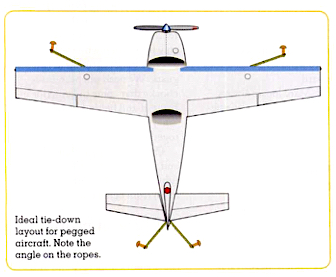 All pilots/owners need, from time to time, to park their aircraft in the open air. Whether it’s just for an overnight stop or for a longer period, it’s important to ensure you do it properly, or you could be up for a big repair bill and potential extra travel costs, including retrieving your plane later.
All pilots/owners need, from time to time, to park their aircraft in the open air. Whether it’s just for an overnight stop or for a longer period, it’s important to ensure you do it properly, or you could be up for a big repair bill and potential extra travel costs, including retrieving your plane later.
Thanks to Australian Flying Magazine, there’s a good article on the subject in the current issue (May/June 2016) under their ‘Masterclass’ heading. Content like this is usually not immediately available online, so unless you are already a subscriber, you’ll have to go and buy a copy from your local newsagent – apart from the tie-down article, there’s a great piece on the Victa Airtourer, surely one of Australia’s classics.
Meanwhile, here’s a brief summary, under the general headings: ‘Park in the right place’, ‘Face the right way’, ‘Brakes or chocks?’, ‘Properly secured’, and ‘Controls locked’ as well as a few general points.
I’ll touch on points relating more to Foxbats and Vixxens – which are high-wing nose wheel aircraft. Different advice may apply to low-wing aircraft and/or tail draggers.
Where to park?
Ideally park as far upwind of other aircraft as you reasonably can; this reduces the chance of another badly secured aircraft blowing over on top of you. Park in the lee of a hangar or thick bushes if possible but avoid large trees, as branches could be blown down on to your plane.
Face the right way
This is perhaps the toughest choice. With the Foxbat/Vixxen always go for pointing into the wind – check the forecast for the parking period and go for the direction with the longest period of the strongest wind. Don’t be caught out by overnight wind shifts and aim for into-wind for the strongest winds.
Brakes or chocks?
Chocks every time! Park brakes can lose their pressure and hot brakes left parked on can blow the brake seals. if your aircraft has to be (legitimately) moved while you’re not there – to avoid a fire for example – it’s easy to pull out the chocks and wheel it away. Make sure the chocks are securely placed and connected so they can’t be bounced out of the way by the wheels rocking in the wind.
Properly secured
First, a big NO to cotton or hemp ropes as they will shrink/tighten when wet and can really bend your plane! Use good quality synthetic tie-down ropes. Another big NO is to chains or ratchet straps, which have no give in them and can severely stress the airframe in gusty conditions. Wing tie-down ropes should be angled outwards by about 30-40 degrees (see the diagram above) and forwards by about 10-20 degrees. Tighten the ropes just enough to stop them ‘snapping’ tight in gusts but don’t over-tighten. Finally, on the Foxbat/Vixxen, tie down the nose by looping the rope over the propeller shaft or lower engine mount tubes (by the firewall) and tying vertically down. If there is any likelihood of a tailwind developing while you are away, also tie down the tail by passing the rope through the tail wheel (Foxbat) or round the skid (Vixxen) – most high-wing aircraft are blown over from the tail.
Controls locked
Twin yoke controlled Foxbats/Vixxens have a locking pin through the right (passenger) side yoke, always insert this to lock fully into the controls whenever you aren’t in the aircraft. Y-stick controls can be locked using the seat belts or the specially designed optional control locking strap. As per a recent service bulletin, do NOT use the centre Y-stick control locking pin for outside parking as it places undue strain on the elevator rod end eyelet, which in extreme circumstances can fracture, leaving the aircraft with no positive elevator control.
Other tie-down comments
The best knot for tie-downs is a bowline. If you don’t know how to tie one – learn! Use a pitot cover to prevent insects nesting and/or water entering the tubes. Use windscreen covers with caution – particularly in windy, dusty conditions, as the grit can get under the cover and rapidly grind your screen to a frosted finish! Felt lined covers are worst – they collect the grit; shiny silver insides are best as the grit has nothing to cling to.
There are quite a few other points in the Australian Flying article, covering taildraggers and longer term parking, as well as some more subtle points worth remembering.
